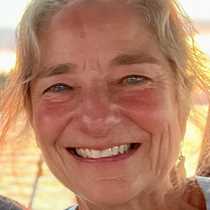Boca de Soledad in Magdalena Bay
Early morning is a gray-white world of fog and calm water. Each Zodiac departs the ship with GPS and compass, and the four boats stick together in the gray monochrome in search of more grey... whales. For the whales, this morning has the same visibility as any other here; beneath the surface reflection, rich plankton makes for green and murky water. After two hours in the fog, somehow, miraculously, in the low, low visibility, whales surface within meters of our inflatable boats. The fog dissipates and it seems we can see forever. During the morning’s next Zodiac outing we see gray whales scattered near the bay’s entrance. There are some mothers and calves, and some lone sub-adults swimming slowly.
In late morning, we take a break from watching whales to stroll along a beach and sand dunes. We find tracks in the sand from mice, lizards, jackrabbits and coyotes. Many of us take cameras along and photograph birds. Lunch today is served on the ship’s sun deck: hamburgers and hotdogs followed by an ice cream sundae bar.
The afternoon’s Zodiacs depart in crystal clear air and light winds. Mother/calf pairs of gray whales swim slowly near the mouth of the lagoon. One pair of whales in particular takes an interest in our Zodiacs. We stop the boats, engines idling, and the whales swim near. Occasionally the mother or calf swims up to a Zodiac. Who is investigating whom? We reach out, splashing the water with our hands. A whale approaches, and we, incredulously, reach further. Human hand touches whale skin, which feels surprisingly soft, spongy and smooth. Our hands touch, and our hearts are touched, too.
Why, oh why do they swim to us?
We celebrate the day with a Mexican Fiesta Dinner, catered by a local restaurant named Ballena Gris (Gray Whale). The delicious meal features fresh grouper and lobster from Magdalena Bay.
Early morning is a gray-white world of fog and calm water. Each Zodiac departs the ship with GPS and compass, and the four boats stick together in the gray monochrome in search of more grey... whales. For the whales, this morning has the same visibility as any other here; beneath the surface reflection, rich plankton makes for green and murky water. After two hours in the fog, somehow, miraculously, in the low, low visibility, whales surface within meters of our inflatable boats. The fog dissipates and it seems we can see forever. During the morning’s next Zodiac outing we see gray whales scattered near the bay’s entrance. There are some mothers and calves, and some lone sub-adults swimming slowly.
In late morning, we take a break from watching whales to stroll along a beach and sand dunes. We find tracks in the sand from mice, lizards, jackrabbits and coyotes. Many of us take cameras along and photograph birds. Lunch today is served on the ship’s sun deck: hamburgers and hotdogs followed by an ice cream sundae bar.
The afternoon’s Zodiacs depart in crystal clear air and light winds. Mother/calf pairs of gray whales swim slowly near the mouth of the lagoon. One pair of whales in particular takes an interest in our Zodiacs. We stop the boats, engines idling, and the whales swim near. Occasionally the mother or calf swims up to a Zodiac. Who is investigating whom? We reach out, splashing the water with our hands. A whale approaches, and we, incredulously, reach further. Human hand touches whale skin, which feels surprisingly soft, spongy and smooth. Our hands touch, and our hearts are touched, too.
Why, oh why do they swim to us?
We celebrate the day with a Mexican Fiesta Dinner, catered by a local restaurant named Ballena Gris (Gray Whale). The delicious meal features fresh grouper and lobster from Magdalena Bay.



